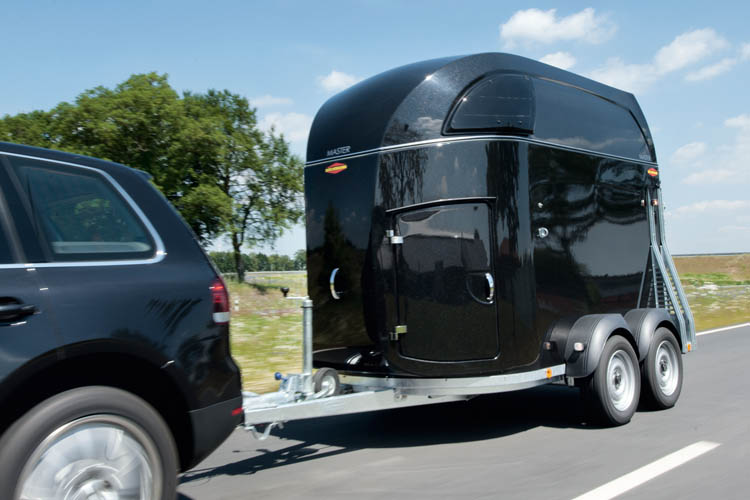Problem horse or problem float?
/There is always a lot of discussion about floats, what brand is best, what features are good, what people like and don’t like. Hearing and reading about float problems and incidents around floating – horses going through the floor and incidents involving chest bars and front windows – as well horses being problem floaters, I thought a great way to approach the horse transport issue would be from a safety and quality point of view.
1 - Focus on SAFETY ...
Stall bars
If your horse panics and rears over the front bars, usually the only way of getting it removed is by an angle grinder unless your float has collapsible stall bars. In this case, the rescue will be much quicker, less stressful for you and your horse and a lot safer without having to enter the inside of the float to release your horse. Ideally, you want both the chest and the butt bars to be released from the outside of the float in case of such emergencies as horses can get stuck underneath the butt bars after a panic or lose balance and go down in the float. It is important that you can easily and quickly remove the entire centre divider for the latter too. Young horses on their first trip are at the highest risk of attempting to jump over the chest bars.
Stall bars should be individually adjustable in height AND length to fit different sized horses to give them the perfect space to travel in.
Make sure there is plenty of headroom ahead of the chest bar to allow the horse to lower its head for balance and clearing its sinuses.
There should be a gap for the tail between the butt bar and the ramp.
Windows & Ventilation
Windows serve a dual purpose of allowing light into the float and appropriate ventilation.
If you have a float with a light interior and a gentle breeze flowing in through the windows versus one which is dark and uninviting with heat radiating from the interior, which float do you think your horse would rather walk into?
Most NZ floats have a non-opening window at the front of the float usually without a protective grill. Windows, especially large ones, at the front of the float are a super quick escape route for panicked horses that don’t understand the concept of 'solid but see-through' resulting in terrible accidents (again highligthing importance of collapsible chest bars!). Horses also can't look out of these front windows because they have a blind spot right in front of their heads and most of these windows are too low providing nothing but an adequate view of the car boot while the world is spinning past their blind spot.
The horses' main vision is towards the side of their head.
Horses are unable to focus their eyes the way humans and most animals can. A horse raises and lowers its head as it looks at an object to adjust the focal length, moving until the object comes into focus on its retina. Since the horse’s field of vision doesn’t overlap, the right eye sees what’s happening on the right side of its body, and the same on the left. If the horse lowers its head and looks up, gazing through the upper portion of the eye, it can focus on the horizon. However, if it needs to look at something closer, it will raise its head to observe the object through the lower portion of the eye, where it can focus more clearly. When you see a horse startled by a sudden movement just behind or beside it, its peripheral vision has sighted the movement but it has not yet had time to focus on it. Even when the horse is traveling a familiar path, such as to the stable or pasture, it can be startled by something as small as a paper blowing past. Therefore, when traveling along in a horse float - especially at heightened speed - judgments that the horse needs to make, relative to its safety, can be very difficult to make for them.
The shutting down of focus leading to stress and unhappiness is the # 1 cause of floating problems of most kinds.
Windows placed around the front corners of the float allow the horse to see out of the window in its direct field of vision allowing them to stand in a relaxed position soaking up the scenery. Horses arrive fresher, more relaxed and far more able to athletically perform. They did not need to try and bend their necks unnaturally to try and get glimpses out of a front window arriving with sore and stiff muscles.
Windows placed around the front corners should be opening windows directing fresh air into the float where it is mostly needed - at the horses' nostrils - then streaming down their flanks and out the back. Additional windows and vents are great. Make sure vents don't flutter increasing the noise level.
Make sure there is an opening at the back for the air to escape as otherwise, you might get a very undesirable air noise inside the float. If you have two side windows make sure the back window is opened more than the front window and not the other way around.
Roof height & Ramp angle and surface
Horses don‘t like to enter small enclosed spaces. So it's important your float is high enough to allow for plenty of head space when a horse enters the float so it doesn't hit its head. 2.3m internal height is a must for any horse above 16.2hh. When a horse approaches the ramp of a float, it immediately assesses the float, but more particularly, whether it can fit in the hole.
The steeper the angle of the ramp, the more it thinks it can't fit in as the horse is made to focus on the roof. Add to that, the fact that the horse has a blind spot directly in front of it, steep ramps and the pre-occupation with the roof immediately creates loading resistance. A steep ramp (particularly with a slippery surface) promote slipping and loss of grip and therefore a loss of confidence. Any such loss directly effects the willingness to reenter a float and resistances begin. If this is not balanced by an ability of an owner to take remedial training action, major float loading problems can occur compounding further the dislike for floating.
A full-length loading ramp reduces the angle of loading and anti-slip rubber matting ideally with safety treads prevent slipping. Make sure the ramp is solid and doesn't flex and sits as low to the ground as possible.
Noise
Horses have highly attuned hearing so you can imagine the dislike for floats that are too noisy inside. Rattling doors, fittings & dividers, flapping dust covers, moving items in your tack room or living area can increase the noise level dramatically. So make sure every fitting is tightened, items are secured safely and stall bars are tight when they are closed. Aerodynamic roof lines eliminate not only the vacuum and sway created when towing conventional horse floats but also considerably lower the noise level inside. Lots of scramblers/wall climbers settle down very quickly after a few outings in a quiet horse float. If stress levels are low, it is also unlikely for a horse to jump over the chest bars.
Horses are highly tuned to the mechanical condition of the float. They can hear and react to new noises like wheel bearings, squeaking breaks, etc. Pay attention if for some reason they might not want to load as easily into your float as they used to or arrive stressed.
Suspension
Would you like to drive a car without shock absorbers? Why should your horse? A comfortable ride ensures that your horses will arrive stress-free and relaxed wherever you go.
Braking system
Your float should have ALL four wheels braked. If you get a flat tyre on the braked wheel of a float with only two braked wheels, you might end up in trouble.
Tyres
What is your back up plan for changing a flat tyre? Have you got a spare wheel and the appropriate wheel brace to fit the nuts on your wheels? The correct wheel brace should be part of your permanent float equipment just like the first aid kit in your car. It's a great idea to have a Tri Leveler (a little ramp) with you to drive onto to change your wheel easily. You won't even have to offload your horses.
Tie-up points
Most often when you are out, the closest thing to a safe tying facility is your float. A lot of floats have very few or no tying points or their tie-up points are dangerously low promoting horses to get their front leg over the rope or ropes getting caught below mudguards. High tie up points ensure the safety of your horse. Don't tie your horse near the spare wheel as the rope might get caught on it. Also check your door handles to make sure lead ropes can't get caught in them.
So, a short list to finish with:
• Yes, look for a well-made float with good fittings, get a technical expert to check it out for you - especially the floor! - don’t compromise safety for price.
• Avoid large front windows
• Avoid anything that sticks out that your horse can catch themselves on – pins, bolts, spring loaded pins and sharp edges
• Insist on collapsible stall bars
• Think about the potential temperature inside the float and make sure there is good ventilation

































